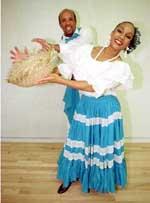Puerto Rican
Folkloric Dance

Guillermo Nolasco and China
Smith
Photo by Ha Lam/For AA-S
By Michael
Barnes
American-Statesman Arts Writer
Posted: Jan. 20, 2000
CULTURAL BACKGROUND: Ana Maria
Maynard, Austin's goddess of Puerto Rican dance, discerns
three main traditions. The bomba derives directly from African
slaves imported in the 1600s. The plena is more urban, and
grew up after the abolition of slavery in the 1900s. A third
lineage, seis, is from mountain peasants, whose dances can be
traced to the 1700s.
COSTUMES: Bomba: The woman is in a white dress
with turban and slip with ruffles, the man in white pants and
shirt, with panama hat and hard shoes (or barefoot). Plena:
Women are attired in knee-length dress, decorated with fabric
or real flowers, with bright taffeta flounces underneath; men
in black pants, with white shirt, suspenders and hat. Seis:
Women in full, solid-color dresses, lots of jewelry, heeled
"character" shoes; men in white shirt and pants, sash,
handkerchief, pava hat (beachcomber) and, especially, a
machete, used dramatically in the dance.
MUSIC: Bomba: Drums with singing and chanting.
Plena: Hand-held drums, trumpets or other brass. Seis: Uses
the cuatro, a stringed guitar-like instrument, and a guiro,
making a scratchy sound, and bongos.
STEPS: Bomba: Free-style, with women shaking
skirts, communicating with the drummer by the height of the
skirt, hips shaking while weight changes; men turn, also
shaking hips, while stamping in a staccato manner. Plena:
Employs the basic step-close-step-close step, with bouncy,
side-to-side changes of weight while partnering. Seis: Women
employ more delicate sliding steps; men hold their bodies
erect, with proud aspect and hands held behind their backs.
CONTACT: Ana Maria Maynard, 251-8122.
Previous
page>>
